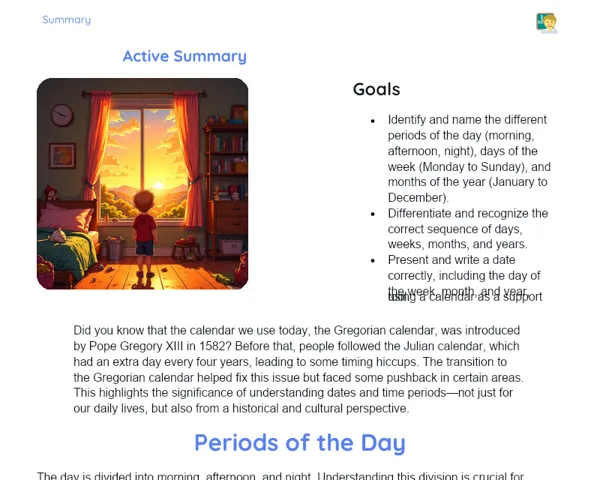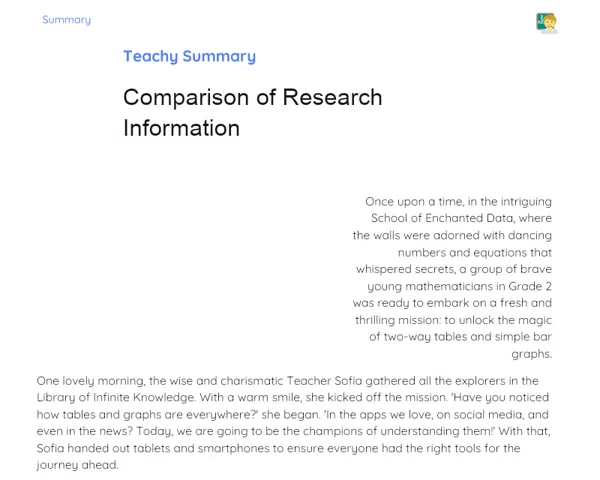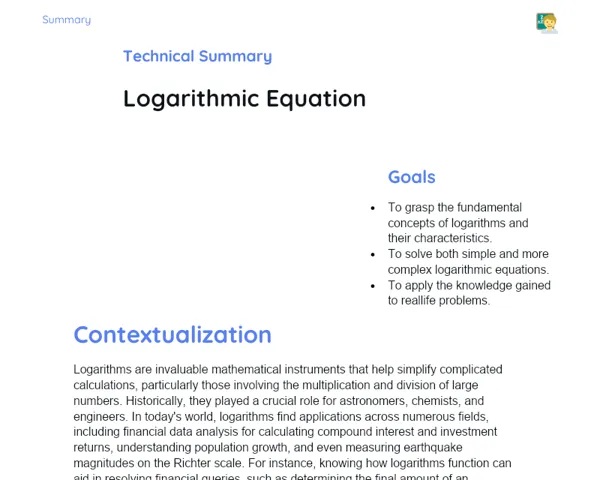Summary Tradisional | Cartesian Plane: Points
Contextualization
The Cartesian plane is a vital mathematical framework that simplifies the visual representation of points, lines, and geometric shapes in a two-dimensional space. It was introduced by the French philosopher and mathematician Renée Descartes in the 17th century. This plane fundamentally changed how we approach geometric and algebraic problems. Each point on the Cartesian plane is indicated by a pair of coordinates (x, y), where 'x' denotes the horizontal position (abscissa) and 'y' represents the vertical position (ordinate). This structure is essential for grasping more advanced concepts in mathematics, which has numerous applications in fields like physics, engineering, economics, and information technology.
The use of the Cartesian plane goes beyond textbook scenarios. In our daily lives, it plays a significant role in modern tech, such as GPS navigation systems, which rely on coordinates to pinpoint locations on Earth. Additionally, it serves as the foundation for generating graphs in economics, weather forecasting, and even in video game development. Mastering how to accurately identify and plot points on the Cartesian plane, along with understanding the four quadrants it consists of, is vital for developing these and many other mathematical skills.
To Remember!
Introduction to the Cartesian Plane
The Cartesian plane is a two-dimensional framework used to locate points through coordinates. This system, created by Renée Descartes in the 17th century, comprises two perpendicular axes: the x-axis (horizontal) and the y-axis (vertical), which intersect at the origin point (0,0). The intersecting axes form four sections known as quadrants. Each point in this plane is depicted by an ordered pair of numbers, called coordinates, indicating its position concerning the x and y axes.
The design of the Cartesian plane aids in visualising mathematical and geometric relationships, thereby allowing for the graphical representation of functions, curves, and shapes. Moreover, it is a necessary tool across various domains, including physics, engineering, and economics. For high school students, grasping the concept of the Cartesian plane is crucial for advancing to more complex skills like graph analysis and solving linear equations.
To effectively utilise the Cartesian plane, students must comprehend the roles of the x and y axes as well as the importance of the origin. Practising how to mark points and identify their coordinates solidifies these fundamental concepts, setting students up for more advanced applications.
-
The Cartesian plane was created by Renée Descartes in the 17th century.
-
It includes two perpendicular axes: the x-axis (horizontal) and the y-axis (vertical).
-
The x and y axes cross at the origin point (0,0).
Coordinates of a Point
The coordinates of a point in the Cartesian plane are represented by an ordered pair (x, y). The first coordinate, x, is referred to as the abscissa and indicates the horizontal position of the point, while the second coordinate, y, is known as the ordinate and represents the vertical position. To pinpoint a point, we move x units along the horizontal axis and y units along the vertical axis.
For instance, the point (2, 3) is positioned 2 units to the right of the origin and 3 units above it. Conversely, the point (-4, -5) is located 4 units to the left and 5 units below the origin. Familiarity with identifying and marking coordinates is fundamental for comprehending how points, lines, and shapes are represented in the Cartesian plane.
It's important for students to practice marking points in various quadrants to build a solid understanding. Additionally, being comfortable with reading coordinates is crucial for tackling more complex problems, such as finding line intersections and analysing graphs.
-
A point is shown by an ordered pair (x, y).
-
The abscissa (x) indicates horizontal positioning, while the ordinate (y) shows vertical positioning.
-
Practising marking points in all quadrants is essential for comprehension.
Quadrants of the Cartesian Plane
The Cartesian plane is split into four quadrants by the intersections of the x and y axes. Each quadrant possesses distinct characteristics according to the signs of the coordinates of the points within.
The first quadrant, situated in the upper right corner, contains points with positive coordinates for both x and y (x > 0, y > 0). The second quadrant, found in the upper left, has points with negative x coordinates and positive y coordinates (x < 0, y > 0). In the third quadrant, located in the lower left corner, both x and y are negative (x < 0, y < 0). Finally, the fourth quadrant, in the lower right corner, has points where x is positive and y is negative (x > 0, y < 0).
Correctly identifying these quadrants is crucial for accurately plotting points and tackling geometric problems. Students should practice locating points in all quadrants to ensure a comprehensive understanding and avoid common mistakes.
-
The Cartesian plane is divided into four quadrants.
-
Each quadrant is defined by the signs of the x and y coordinates.
-
The first quadrant contains positive coordinates for both x and y, whereas the third quadrant has negative coordinates for both.
Problem Solving in the Cartesian Plane
Solving problems in the Cartesian plane entails the practical application of concepts related to coordinates and quadrants. Problems can vary from simple point marking to analysing functions and line intersections. Engaging in problem-solving helps students consolidate their understanding and actively apply their knowledge.
Basic examples of problems include identifying the quadrant of a point based on its coordinates. More intricate issues might involve calculating the distance between two points, determining the equation of a line passing through two points, or finding the intersection of two lines. Successfully navigating these problems requires a strong grasp of the essential concepts of the Cartesian plane.
Students should be motivated to tackle a range of problems to enhance their analytical and problem-solving skills. Regular practice reinforces learning and equips students for more complex challenges in mathematics and other subjects.
-
Problem-solving involves applying coordinates and quadrant concepts.
-
Problems can range from plotting points to analysing functions and line intersections.
-
Regular practice reinforces learning and enhances analytical skills.
Key Terms
-
Cartesian Plane: A two-dimensional system for locating points through coordinates.
-
Coordinates: An ordered pair (x, y) that defines a point's position in the Cartesian plane.
-
x-axis: The horizontal axis of the Cartesian plane.
-
y-axis: The vertical axis of the Cartesian plane.
-
Origin: The point where the x and y axes intersect, represented by (0, 0).
-
Quadrants: The four sections of the Cartesian plane defined by the signs of point coordinates.
-
Abscissa: The x coordinate of a point, indicating horizontal position.
-
Ordinate: The y coordinate of a point, indicating vertical position.
-
Renée Descartes: French philosopher and mathematician credited with developing the Cartesian plane.
Important Conclusions
In this lesson, we explored the structure and significance of the Cartesian plane, as devised by Renée Descartes. We learned how to identify and mark points using coordinates (x, y) and recognised the four distinct quadrants of the Cartesian plane. These skills form the foundation for grasping advanced mathematical concepts and their practical uses across various fields.
The Cartesian plane is not merely theoretical; it has substantial practical applications in areas like GPS navigation systems, economic modelling, and climate data analysis. Being able to accurately pinpoint and mark points, along with understanding the quadrants, is crucial in honing advanced mathematical skills and solving intricate problems.
We encourage students to continue delving into this topic, as mastering the Cartesian plane is essential for success in disciplines that employ graphical representation and spatial reasoning. Continuous practice and resolving diverse problems will enhance understanding and prepare students for future challenges in mathematics and beyond.
Study Tips
-
Practice marking and identifying points in the Cartesian plane using different coordinates and quadrants to reinforce understanding of the foundational concepts.
-
Work on problems that involve calculating distances between points, determining the equations of lines, and identifying line intersections to apply knowledge in a practical context.
-
Make use of additional resources like educational videos and interactive apps to visualise and explore the Cartesian plane engagingly and dynamically.



